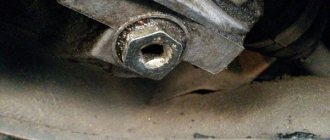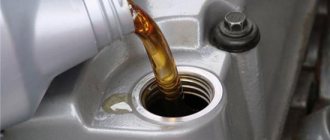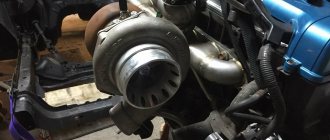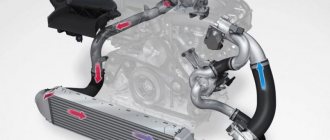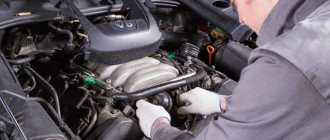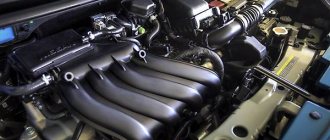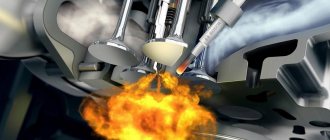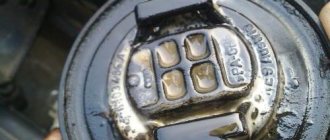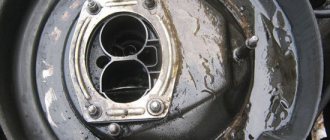The breather is an important component of the crankcase ventilation system on a car. But sometimes it happens that oil starts to come out through it.
This is an uncharacteristic sign for a working engine, so if such symptoms appear, you should think about diagnostics.
You don’t have to go to a car service center and pay money for it. Many motorists cope with the problem on their own. To do this, you need to know a minimum of theory and understand the essence of the operation of the crankcase ventilation system.
Formation of crankcase gases
During the combustion of working mixtures, exhaust gases accumulate under high pressure in the engine cylinders. Due to pressure, some of the gases seep into the crankcase. There they are mixed with oil vapors and condensate moisture. The resulting gas mixture is called crankcase gases.
As pressure increases, the gas mixture breaks through the following elements:
- oil seals;
- breather;
- oil dipstick output;
- seals.
If a characteristic effect called “oil drives” appears, it means that when gases escape, motor oil is involved. To stop moving oil from the breather of a diesel engine, it is necessary to maintain the pressure inside the engine within acceptable limits by removing crankcase gases through the ventilation system.
Why does oil flow through the breather: reasons
First of all, this is the wear of the CPG. Usually the rings wear out, causing pressure to increase. As a result, the system begins to throw out oil. The release occurs under high pressure, and here filters (usually an ordinary mesh) are not able to help.
Another common reason that the system throws oil through the breather is that the oil deflector is clogged to capacity. If ventilation is impaired, the working fluid in the form of evaporation seeks workarounds around the purifier. Oil begins to fly out through the breather.
The air filter may also become clogged. The system takes in air through other sources, including the breather. But in this case the air mass is taken together with the working fluid.
An increase in the fluid level can also cause it to escape through the breather valve. Sometimes car owners do not spare oil and pour it to the very level, which goes against the manufacturer’s requirements. As a result, excess liquid passes through the prompter.
The breather valve may become stuck, allowing gases to enter the crankcase. This leads to an increase in pressure in the system and, as a consequence, to the release of working fluid through the breather.
Operating principle of the engine ventilation system
The design of older models of internal combustion engines included the simplest ventilation system designs; they included only one breather, which was located in the crankcase. It was a link connecting the inside of the cylinder block with the atmosphere, and crankcase gases escaped through it.
This scheme had a significant drawback: the exhaust gases contained oil particles, which were dispersed in the external environment. The negative effect led to significant losses of lubricants and was also a serious factor polluting the atmosphere.
Modern diesel and turbo engines are equipped with closed ventilation systems. A special pipe is connected to the breather, through which exhaust gases are discharged into the cavity of the intake manifold or to the air filter for further movement into the cylinders to participate in the combustion process.
Improved designs eliminate the causes of environmental pollution and do not allow oil particles to be driven into the atmosphere.
On top of that, each engine is equipped with special elements that separate oil particles from gases and return them to the crankcase cavity.
Depending on the manufacturer and model of the car, there are several options for oil separation devices, which differ both in design and in operating principle.
The ventilation systems of diesel power units of modern cars include the following elements:
- Oil separator.
- Breather.
- Two pipes.
- Gas pressure valve.
The appearance of the systems may differ depending on the car model, but the principle of operation and purpose remain the same.
If the engine is breathing, what to do?
Before answering the question: “Why is the engine breathing?”, it is necessary to understand what exactly is meant by this formulation. As a rule, this phrase characterizes the manifestation of excess gases in a power plant. Characteristic signs of this phenomenon can be considered smoke from the neck where oil is poured, leakage of working lubricant in various parts of the engine (breather, seals, etc.).
Oddly enough, if the engine starts to breathe, it’s too early to talk about any breakdown; you need to figure out what the reason is, since this phenomenon can manifest itself not only in units with high mileage, but also in completely new units, both gasoline and diesel
The breather is a special valve-type device designed to equalize the pressure inside the crankcase of the power plant with the ambient pressure. The process is quite simple: when pressure rises above atmospheric pressure, the valve opens and releases excess vapors to the outside, thereby ventilating the crankcase and removing gases.
Description of the design of the VAZ 2110 engine ventilation system
The breather with a fixed end of the pipe is located in the lower part of the cylinder block. The opposite end of the pipe connects to the oil separator located in the cylinder head cover. On the opposite side of the head, a special tube is connected to the fitting. This tube is connected to the air inlet pipe.
The operation of the system consists of the following stages:
- The passage of gases into the cavity of the head cover through the diesel breather.
- Separating the oil in the oil separator and supplying it to the valves.
- Mixing and supplying gases to the manifold through the air pipe.
The power unit of this car model is not equipped with a valve that regulates exhaust gas pressure.
In other cars, oil separators may be located in the area of the breather, behind which the pressure valve is located.
Breather operating principle
The oil breather, or breathing valve, is a safety mechanism that relieves the pressure formed in the oil cavity of the motor or gearbox. In the internal combustion engine, the element is integrated into the crankcase ventilation system. It is designed to ensure the recovery of exhaust gases that break into the internal density through leaks and gaps. In addition, the system equalizes the pressure inside and outside the engine, and also prevents dust from getting inside when the unit cools down.
The element is placed in a variety of places in the lower part of the engine block, for example, in the Lada Priora it is installed in the oil pan. It can be made as a separate part or integrated into the housings of various components. It works in conjunction with oil separators and pipes that ensure the movement of crankcase gases.
The internal combustion engine breather is a very simple element in design, has no moving parts, and there is nothing to break in it. It is usually represented by a metal fitting onto which a hose is attached. However, the performance of the motor depends on it. If it becomes clogged, the pressure of gases in the crankcase will increase, which will seek another outlet into the atmosphere through weak points.
How to detect oil leakage through a diesel breather
The performance of this system is very important for stable engine operation. Oil escaping through the diesel breather is the most common ventilation problem.
If this defect is not detected and eliminated in a timely manner, serious damage to the internal combustion engine may occur:
- oil particles entering the cylinders and manifold;
- clogging and clogging of channels;
- increase in the amount of soot during combustion;
- soot getting into the oil sump;
- coking of oil channels;
- deterioration of the lubrication system.
Signs of oil leaking through a diesel breather include the following effects:
- Leaking grease inside the air filter.
- The presence of abundant oil traces on the outer surface of the filter device of the carburetor engine.
- Oil deposits on the throttle mechanism and the inner surface of the intake manifold.
- Reduced engine power.
- Increased fuel consumption.
What can you put in the engine to stop it smoking?
What should you put in the engine to prevent it from smoking?
Anti-smoke - an additive to prevent the engine from smoking
How to eliminate oil gluttons without capital?
You can remove oil from a car without engine capital with ordinary water. This remedy is ordinary water! With the help of water, which enters the engine in small quantities, under high temperature and pressure, it turns into steam and knocks out all the sludge. May 7, 2022
What kind of oil should I put in the engine to prevent it from smoking?
As we found out above, an additive that reduces smokiness thickens the oil. Accordingly, a similar effect can be obtained by pouring thick oil. Fill with 5w-50 or even 10W-60 oil! Yes, this oil is quite expensive (at the time of writing about 500 rubles per liter), but this oil will not damage the engine as much as the additive. May 10, 2022
What should I put into the engine before selling?
So, if you want to have an extra hundred, do the following before selling your car:
- Fill the engine with fresh oil. ...
- If the engine is diesel, thicken the fuel. ...
- Again, if the engine is diesel, treat the fuel injection pump with fluoroplastic. ...
- Reduce spark plug gaps to 0.8 mm. ...
- Clean the engine.
What additives reduce engine oil consumption?
Rating of additives that reduce oil consumption
- Hi-Gear OIL Treatment Old Cars & Taxi. ...
- Resources Universal. ...
- Liqui Moly Oil Additive. ...
- Bardahl Turbo Protect. ...
- Suprotek Universal-100.
When to pour the additive into the engine?
After the additive gets into the car gasoline tank, you need to immediately pour fuel into it so that they mix. If the additive is poured into engine oil, this must be done at the time of oil change. The additive can only be added to “fresh” oil when a new fuel filter is installed.
Why does my car smoke a lot and eat oil?
If the engine consumes oil and the oil consumption is high, then the release of blue (gray, almost white) smoke indicates oil getting into the cylinders, gases breaking into the crankcase through the rings (this indicates that the rings and cylinders are worn out). If the engine does not smoke much, it is advisable to measure the compression in the cylinders.
How to check if there is oil in the engine of a car?
To determine the oil level, you need to warm up the engine to its operating temperature and, with the engine running, slightly open the oil filler cap. If blue smoke comes from there, this will indirectly mean that the engine is consuming oil. May 5, 2020
Which oil burns the least in an engine?
Since the fuel is the same, all differences beyond the measurement error limit can be attributed to the so-called non-fuel CH, generated by the evaporation and combustion of oil in the cylinders. The result confirms our assumptions: oil with a higher flash point burns less.
Which additive is best for a high mileage engine?
It is better to use an anti-friction additive for an engine with high mileage (over 250,000 km). It allows you to restore the power unit from the inside: microcracks on the cylinder walls are eliminated. As a result, compression increases and the power of the power plant increases.
How do engine additives work?
The use of the additive will increase the oil viscosity, increase the pressure in the system and reduce oil waste. ... The additive in combination protects the engine from wear, facilitates the movement of parts, reduces operating noise and fuel consumption, in total this allows to increase the service life of the engine.
What are the causes of oil leakage?
Lubricants can escape through the diesel breather not only due to breakdowns in the ventilation system. This defect is also observed due to the following reasons:
- Increased wear of piston rings, destruction of surfaces in cylinders and pistons lead to the passage of a large amount of gases into the crankcase, which ventilation is not able to cope with. This situation leads to increased pressure, at which oil is squeezed out through the breather.
- Blockages in the oil separator drain channel lead to the mixing of separated oil into the passing gases.
- Air filter clogged. With this defect, the engine does not have enough air, and it begins to use air masses from the ventilation, contaminated with oil inclusions.
- An increased amount of engine oil in the lubrication system leads to excess entering the ventilation system.
- Failure or obstruction of the ventilation valve.
- Wear of the gas distribution mechanism and valve burnout lead to the entry of crankcase gases into the space above the valve and into the crankcase cavity, which contributes to an increase in pressure in the engine.
Piston rings
Another detail that often causes diesel to breathe. The rings are designed to seal the gap between the pistons and cylinders; they are selected with a high degree of precision and provide them with good compression. But, if for some reason they do not perform their functions, exhaust gases penetrate into the crankcase. The problem is also detected when measuring compression and most often occurs for two reasons:
- Wear of elements, as a result of which they become thin and cannot properly seal the space. Sometimes the rings become so thin that they simply break, which can damage other components and complicate repairs.
- O-ring jamming occurs most often in cars that have been standing for a long time. That is, the elements stick to the pistons and do not seal the clearance, which is why the engine begins to breathe heavily. Also in this case, the engine malfunction lamp may come on periodically or constantly work.
In some cases, the oil can be squeezed out very strongly, it all depends on the extent of the problems with the rings and the amount of exhaust gases entering the crankcase. The main difficulty is that the cause is revealed only after removing the cylinder head.
Carrying out diagnostics of lubricant output
To identify the causes of a defect in the flow of lubrication through the breather of a diesel and turbo diesel engine, it is necessary to conduct a comprehensive check of the power unit. This does not require disassembling the engine. Experienced craftsmen measure certain parameters and visually assess the condition of the elements included in the ventilation system.
If plaque and oil deposits are detected in the intake manifold, it is concluded that there is a lubricant outlet through the diesel breather seals. To carry out diagnostics, you will need a set of tools consisting of open-end wrenches, screwdrivers, and a compression tester.
Algorithm of verification activities:
- Analysis of the state of exhaust gases. This turns on the engine and checks the color of the exhaust. A black or bluish tint indicates that oil is getting into the cylinders, because there is wear and sticking of the oil scraper rings, and there are also problems in the operation of the gas distribution mechanism.
- Check compression in each cylinder. The compression value, equal to 11 - 13 MPa, indicates proper operation of the cylinders and pistons. The difference between compressions in the cylinders should not exceed one megapascal. Low compression of one of the cylinders may cause lubricant leakage.
- Using a glow plug, the specific cause of the defect in a given cylinder is determined. The spark plug is removed and checked for strong traces of carbon deposits, which indicate defects in the cylinder-piston group.
- The absence of carbon deposits on the spark plug indicates that the valves need to be checked.
- If compression is normal in all cylinders, it is necessary to further check and clean the elements of the ventilation system. All incoming devices must be dismantled and thoroughly washed, dried, and then reinstalled.
Fault diagnosis
If black or bluish smoke comes out of the exhaust, this is a sign of a malfunction of the valves - they could have burned out. The rings could also become deformed. In this case, you need to measure the pressure in the cylinders. In gasoline engines it should be at the level of 11-13 MPa, in diesel engines - 20-32 MPa.
To understand the degree of contamination of the prompter, you need to unscrew the pipes from the lid. If they are very dirty, we clean them with special products or just gasoline. To check the oil separator you will have to unscrew several bolts. Then we take out the unit and assess its condition - if it is clogged with carbon deposits, wash and dry it.
Sometimes the valve may stick a little, which leads to gases entering the crankcase and increasing pressure. As a rule, this problem is solved by flushing the unit. However, in order to wash it, you will have to first dismantle it.
To distinguish between stuck piston rings and burnout of one of the valves, we check the pressure in the cylinders - we need to determine the cylinder with the lowest pressure. Then we inspect the spark plug of this cylinder. If the rings are stuck in this cylinder, there will be carbon deposits on the spark plug. If the problem is the valve, the spark plug will look normal.
Way to solve the problem
When starting to clean the breather, first of all we look for a device under the hood and remove the air filter from it.
Before doing this, de-energize the car by disconnecting the negative terminal from the battery and turning off the ignition. There is an intake manifold under the filter - we will also dismantle it. After this, you can see the prompter itself - as a rule, its cover is secured with two bolts, which will have to be unscrewed. After removing the cover, the oil bumper will become visible - it is secured with a pin. Read more: 220 Volts in Watts
It is necessary to unscrew the nut located on the stud, but there is no need to remove the stud itself, because it will be difficult to put it back without dismantling the pan. We make a cleaning rod out of wire, which we use to clean the tube. There is a brush on the breather cover to extinguish the flame - we clean that too.
All that remains is to check the device. We start the engine, remove the plug from the oil filler neck, and cover the neck itself with your palm. You can feel with your hand whether there is pressure. Then the assistant should press on the gas until the speed reaches 100-130 km/h and check the compression again by applying the palm of his hand. A little pressure should already be felt.
To avoid problems with the release of working fluid through the prompter, it is necessary to constantly monitor its level
It is also important to pay attention to checking the filter and gearbox
Owners of old domestic cars, after several years of ownership, can easily write a directory of “diseases” of a particular car model. One of these “sores” is an engine malfunction in which engine oil is squeezed out through the breather. This phenomenon is most often simply called by people: “oil is driven through the breather” or “oil is thrown out through the breather.”
The problem is quite unpleasant and is accompanied by a large number of engine-related problems. It is this problem, as you probably already guessed, that we will talk about in this article. You will learn why oil comes out of the breather and how to solve this problem. Go.
As a rule, the problem occurs with the onset of cold weather, the breather freezes and the oil is squeezed out. This manifests itself in the form of oil drips that are visible from the outside of the engine. Failure to respond to this phenomenon in a timely manner can lead to serious engine damage.
DOMOSTROYPlumbing and construction
Hello, please tell me who has had experience.
Oil flows through the engine breather on a new KAMAZ.
MILEAGE 15,000 thousand
- Login or register to post comments
The reason for oil leakage through the breather in KAMAZ engines
For your convenience, I will repeat the answer.
In my experience, the reason for oil leaking through the breather is simple - high oil level .
The fact is that guides for oil dipsticks come in two types .
And these guides differ in length by a couple of centimeters.
If the guide was installed at the factory too long, then everything is obvious - constant oil overflow and leakage through the breather.
I recommend that you drain the oil and check the resulting volume to ensure it corresponds to the engine specifications.
Best regards, Vladimir Danielyan. Head of the purchasing department of NPO KamAgregat-Service, Naberezhnye Chelny
- Login or register to post comments
Piston failure is the cause of oil leakage through the breather
I would like to complement Vladimir. Yes, there are (but very rare) cases of filling the wrong amount of oil. But the main reason for oil leakage through the breather is excess gas pressure in the engine crankcase due to gas breakthrough .
Gas breakthrough usually occurs due to a malfunction of the piston group.
The engine should be diagnosed. Usually, they start with a compression measurement.
And here I would like to draw your attention to the fact that, as such, the concept of compression for KAMAZ engines, generally speaking, does not exist. There is a compression ratio (16.5 for KAMAZ 740 family engines). However, it has been experimentally established that on a working KAMAZ engine the compression should be in the range of 27–29 kgf/ cm2 .
Compression measurement is carried out by rotating the starter with a working battery, which will ensure a crankshaft rotation speed of about 230 rpm.
At the KAMAZ Scientific and Technical Center, compression is usually measured at 100 rpm, and they believe that a working engine should show a compression of at least 26.5 kg/cm 2 .
The permissible compression variation between cylinders should not exceed 1-2 units.
I would also like to note that if low compression is detected, you should not blame only the rings; valves can also leak.
Best regards, Evgeniy Kudryashov. Director of the Nizhny Novgorod branch of NPO KamAgregat-Service.
- Login or register to post comments
Oil flows through the breather. Reaction of the technical center.
I brought it to the CenterKamaz in Belgorod for TO-2.
The heads were removed. They said the heads were good, but didn’t ask about compression.
I think they measured it before removing the heads.
They said it was an isolated incident and they didn’t know what to do.
We decided to think about it until Monday.
(They brought a new one 2000 km already with a leak).
It doesn't smoke, the traction is good, and the oil flows.
- Login or register to post comments
Another reason for oil leakage through the breather is the air compressor.
Besides the piston, there may be another reason.
Problems with the crankcase ventilation system
In the ragged rhythm of the engine, during acceleration, off-road driving, the burning fuel-air mixture creates pressure much higher than usual. This increases the volume of gases penetrating through the piston rings into the engine sump. Properly functioning pan ventilation allows gases to move freely into the intercooler, and then into the combustion chambers along with the air-fuel mixture. Due to the fact that the operation of the oil trap gradually deteriorates, as well as the valve springs, the pressure in the pan increases, which is why the exhaust gases begin to drive oil droplets into the intercooler.
After cooling, the oil that gets into the intercooler accumulates at the bottom of the radiator. In addition, the oil begins to lose its properties, which causes the turbine’s lubrication to deteriorate and wear marks to form on the shaft. Another negative aspect that can result from poor functioning of this system is a decrease in engine power and an increase in fuel consumption. Due to the fact that the air flow throws oil into the intercooler, and from there it enters the cylinders, the fuel combustion mode changes.
VAZ 2106/ Troubles the Engine, Found the Cause/Ride/And I Disassemble the Jig.
VAZ 2106 / engine troubles, found the reason / rides / and disassemble the jig.
Creator: Owner of combat classics
Posted: Sep 21 2022 Views: 7,873 Likes: 109 Dislikes: 16
Thank you for watching our video! Give it a like! Subscribe to our donation channel for nishtyaki money.yandex.
ru/to/410014593027544 Owner of combat classics, these are noteworthy and educational videos every time=On the subject of advertising and cooperation:
ru Rules of conduct on the channel: 1) it is prohibited to use offensive and/or otherwise profane words and expressions addressed to the channel administration and/or other users;3.
5) manifestations of brutal xenophobia, chauvinism, racial intolerance, incitement of ethnic hatred and/other enmity are prohibited; 3) the rules will be supplemented and/as it is also called changed by the administration in a one-sided manner; 4) violation of the Rules leads to a BAN of the user. additional description do not read .
#2101#2106#2103
zhiguli, garage find, low mileage, kapsula vremeni, shokha, export, time capsules, auto show (event), vaz-2107 (automobile model), ussr cars, automobile (tv genre), lowmiles, lada, lada riva, time capsule , low milleage, roma urraco, barnfind, vaz, vaz- 2106 , ussr car, ussr, time capsule, garage find, low mileage, Lada, Lada, vaz, vaz- 2106
, VAZ-21063, Roma Urraco, barn (building function), barn find, six, lada-
2106
, Nakhodka, Japan, gaz, volga, wolga, gaz-310garage.classic, retrocar, VAZ 21099, car inspection before purchase, review of VAZ 21099, subb, avtovaz (automobile company), lada-
2106
, AvtoVAZ, 1st launch, new VAZ, zhiguli, car selection, lada 1300, avtovaz, kopeck, vaz-2101, vaz-21011, vaz-21013, low miles, vaz-2101, 2101, 21013, vaz-21013, youngtimer, youngtimer, test drive, zhorik
KEY-DOP
VAZ 2107, time capsule, not a bad car, car, car, a boy's car, a boy's car, car, trolley, Lada, Lada owner, excellent condition, preserved, Tkachenko, zhiguli, garage find, low mileage, kapsula vremeni, Shokha, export, time capsules, auto show (ev Lada, VAZ, VAZ-2106
, vaz-21063, roma urraco, barn (building function), barn findbarge, raf-2203 (automobile model), ussr microbus, raf, rafik, holo, japan, brand new six, vaz 2101,
Youtube tags: #new #project #breakdown #repair #520i #m20b20 #pskov #pskov #blog #blog #pakhaimaks #gvr #gvr #auto #auto #show #show #tuning #police #police #pursuit #hide and seek.
2106 2106 troit 2106 troit engine vase engine find troit
Air filter clogged with dust
When the intake valves open, the connecting rod goes down, and a significant vacuum is created in the pipe connected to the outlet of the pan ventilation system. When the air filter is clogged, due to the difference in pressure in the pipe and the pan, gases escape much more intensely, taking oil particles with them. In this case, the efficiency of the oil trap decreases, and the lubricant flies into the intercooler. In addition, air deficiency affects the quality of the combustible mixture. The fuel-air emulsion becomes too rich, and lubricant particles that enter the combustion chambers further change the proportion of fuel to air.
Turbine malfunction due to seal damage
The turbine's service life is designed to last about 150 thousand km, provided that high-quality lubricant and standard pressure are used in the oil system. A drop in oil quality or an increase in pressure leads to a leak in the oil seal, which causes the turbine to throw lubricant into the intercooler. The radiator can serve as an oil catcher for some time, preventing lubricant particles from entering the combustion chambers. When the oil level in the intercooler reaches the limits of the lower cells, a carburetion effect is created and lubricant particles are drawn into the air flow, changing the properties of the combustible mixture.
The best additives for engines against oil waste, how to choose?
What additives do manufacturers produce?
Commercially available products for mixing with motor oil prevent the formation of corrosion and carbon deposits in the engine. They influence the technical characteristics of lubricating fluids, change their pour point, composition viscosity and other technical characteristics on which engine operation depends.
Add additives to engine oil in accordance with manufacturers' recommendations. Once in the internal combustion engine, they cover the surface of its parts with a protective film that has an anti-corrosion composition. This increases the operating life of the unit and reduces engine oil consumption during vehicle operation. Additives are used for:
- coke deposits on piston rings;
- the appearance of chips, cracks and burrs inside the unit;
- reduction of compression;
- significant wear of the cylinders.
The effectiveness of using additives depends on the correct choice of the right product. When purchasing them, the operating conditions of the vehicles are taken into account.
The best additives that are added to oil and reduce its consumption (zhor)
| Place | Name | Price |
| 5 | ER-8 additive | 1000 ₽ |
| 4 | VMPAUTO Resources Universal | 450 ₽ |
| 3 | Bardahl "No Smoke" | 1000 ₽ |
| 2 | WYNN'S W74944 Super Charge | 470 ₽ |
| 1 | LIQUI MOLY Visco-Stabil | 650 ₽ |
ER-8 additive
Country of origin: USA. The additive belongs to the group of antifriction metal conditioners. It is produced at a plant that is part of the Hi-Gear Corporation. The product has a unique composition and is designed to protect engine parts from wear due to friction that occurs between them during operation of the unit.
When adding ER-8 to engine oil, the noise level of the operating unit is reduced. The effect of using ER-8 can only be achieved when it is added to high-quality lubricating fluids. In combination with low-quality motor oils, savings in their consumption are not noticeable. The list of lubricating fluids compatible with the additive is indicated in the manufacturer’s instructions and on its official website.
When using ER-8, engine power increases and fuel consumption decreases by approximately 1.1%. It is necessary to pour the additive into the engine only after replacing it. Adding the product to a highly contaminated lubricating fluid does not give a positive result.
Pros:
- reduction in engine oil and fuel consumption;
- increase in engine torque;
- affordable price.
Minuses:
- The main disadvantage is the inability to use the additive for all types of engines.
VMPAUTO Resources Universal
Country of origin: Russia. The additive is designed to clean and protect against wear of gasoline engines. The composition of the product contains tin, copper and silver. They create a protective layer on the surface of engine parts that can smooth out small surface defects. This allows the engine to be restored without disassembling it.
Add Resurs Universal to the engine oil after the engine has warmed up. After pouring the product into the engine, allow it to idle for at least 15 minutes. When using this type of additive, engine wear is reduced by approximately 4 times. Its action begins from the first seconds after pouring. A noticeable effect when using Resurs Universal is achieved after 150 km of run. Fuel savings can reach up to 10%, and waste is reduced by 5 times.
Pros:
- restoration of compression up to 40%;
- increase in engine efficiency by 2-3%;
- reduction in engine oil consumption by 3 times.
Minuses:
- The main disadvantage is that the effect of using the additive can only be achieved if the instructions for its use are strictly followed.
Bardahl "No Smoke"
Country of origin: USA. The additive works especially well when the power unit overheats. Under such conditions, it reduces the ability of motor oil to penetrate the fuel combustion chamber, forming a barrier in its path. The product has an anti-smoke effect. It covers the surfaces of internal engine parts with a protective film, increasing the service life of engine oil.
The additive can be used for all types of gasoline, as well as diesel and liquefied gas internal combustion engines. It is compatible with synthetic, semi-synthetic and mineral motor oils. Pour Bardahl “No Smoke” into the engine after changing the oil in a well-warmed engine. After this, it is allowed to idle for 5-10 minutes.
Pros:
- increases oil pressure;
- neutralizes smoke;
- reduces engine noise and oil consumption.
Minuses:
- The main disadvantage is the high cost.
WYNN'S W74944 Super Charge
Country of origin: Belgium. Wynns Super Charge is a dual purpose product. It reduces engine oil consumption and restores compression. Pour it into the oil after the engine has warmed up to operating temperature. The product exhibits excellent properties at high temperatures and engine operation under heavy loads.
It is mainly used for filling into the engines of cars that travel long distances every day, operate in mountainous areas, when driving with a trailer, as well as for diesel vehicles. Wynns Super Charge can also be used for gasoline units. The manufacturer recommends using the additive for old units with a high degree of wear.
Pros:
- reduces engine oil consumption;
- protects the surfaces of internal parts of internal combustion engines from corrosion;
- increases the working life of the unit;
- does not destroy catalysts.
Minuses:
- No deficiencies identified.
Replacing the breather of the gearbox VAZ 2108
Frequency of oil changes in VAZ gearbox 2108
-2109-21099
- 1
- Transfer - 2
- oil drain plug
The oil change frequency is every 75,000 km or every 5 years.
Gearbox crankcase capacity
- five-speed - 3.3 liters;
- four-speed - 3.0 l.
It is recommended to drain the oil immediately after the trip, while the Samara Lad is still hot.
Keep moving oil level
always closer to the upper mark, but it should not exceed the upper mark, otherwise oil may leak out of it.
Gearboxes
.
Cleaning the fan of a VAZ 2108 2109 21099 car. If the engine supplies oil through the distributor or throws out the air filter. the breathing apparatus must be cleaned. The lower mark indicates the minimum permissible oil level
. Shoe holder 2108 2109 21099 — logbook. If the oil level drops below this mark the gears will not be well lubricated. List VAS 2108 will quickly fail.
Replacing the breath of a VAZ Classic gearbox
Don't try to do this with a haircut. Ventilation valve VAZ 2108 Replacement of ball bearings VAZ 2108 and others. I've already tried it. Breathing box (What should I do?) VAZ-forum 2108. Didn’t work.
The breathing checkpoint is where it is.
where is the VAZ gear fan
- classic advice on this matter
is replacement
.
breathing
what it is and why HERE:
1.
Before changing the oil, remove the rubber cap, wash it and wipe the hole in the breathing tube with wire. Then replace the cap.
2.
Unscrew the oil drain plug, having first replaced the oil tank with the satellite gearbox. We clean the VAZ 2108 fan when we set the fan speed to short. Drain the oil and tighten the oil drain plug.
3.
Remove the oil level indicator (sensor).
4.
Add new oil through the dipstick using a funnel.
5.
Wipe the pointer with a cloth and reinstall it.
6.
Remove the probe and check the oil level in the VAZ 2109 again. If necessary, add oil to the gearbox to the upper mark.
7.
On earlier transmissions (without an oil rod), the oil filler neck is located above
8.
Disconnect the plug and fill the VAZ 21099 gearbox with oil using a syringe from the bottom edge of the oil filler.
https://vaz2109.net/dvigatel/sapun-vaz-2109.htmlhttps://twokarburators.ru/prochistka-sistemy-ventilyacii-kartera-dvigatel-2108-2109/https://carmanuals.ru/vaz/vaz- 2109/tehnicheskoe-obsluzhivanie-avtomobilya/ochistka-i-promyvka-detaley-sistemy-ventilyacii-karterahttps://vaz-russia.com/remont-vaz-2108/ochistka-sistemyi-ventilyatsii-kartera-na-vaz-2108- vaz-2109-vaz-21099.htmlhttps://autotexnika.ru/zamena-sapuna-kpp-vaz-2108/
What to do if there is oil in the intercooler
If grease is detected on the surface or inside the radiator, you need to diagnose the cause of its appearance. What you will need for this:
- check the operation of the pan ventilation;
- replace the filter;
- inspect the seals.
If you have no experience in carrying out such work, you can contact specialists at the service center. If the engine is fully operational, based on the diagnostic results, it is worth adjusting your driving style. Thus, operating the power unit at speeds above 2000 per minute leads to excessive heating of the coolant, especially when driving uphill in mountain serpentine conditions.
After completing these measures, flush the intercooler. To do this you will need:
- remove the intercooler from the power plant, using the recommendations from the vehicle maintenance instructions;
- clean the outside of the radiator from oil and dirt;
- The question of how to flush the intercooler is easily solved; for this purpose, gasoline, kerosene, and acetone are used in equal proportions. This mixture is poured inside the radiator for 12 hours;
- For subsequent cleaning of the intercooler from residual flushing mixture, dishwashing detergent mixed with hot water is suitable;
- Flushing the intercooler is completed with clean heated water.
Prompt detection of oil in the intercooler will allow engine malfunctions to be eliminated in a timely manner, preventing a deterioration in its operating parameters. At all stages of radiator flushing, personal protective equipment should be used and detergents should not come into contact with exposed areas of the body.
Optimal operation of the turbocharger is only possible when the rules for using this high-precision mechanism are followed, otherwise problems will arise. Often the cause of breakdowns is the oil in the turbine. What to do if the turbocharger drives oil?
